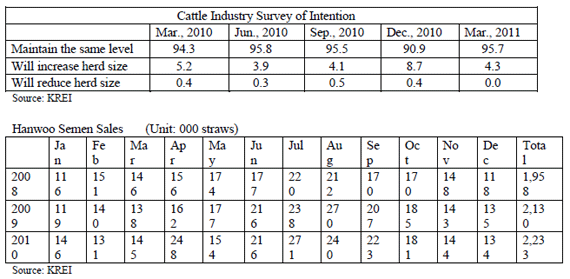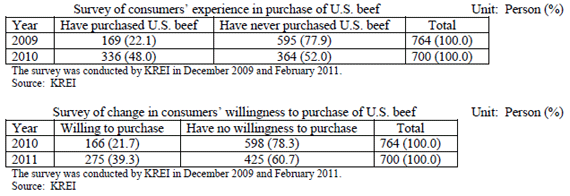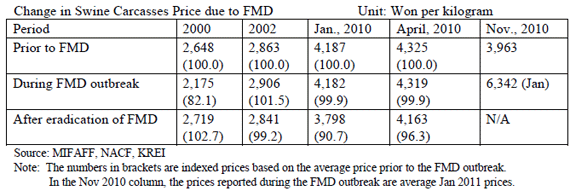



South Korea Livestock and Products Semi-annual Report 2011
The FMD crisis is winding down and is expected to come to an end by mid March, according to the USDA Foreign Agricultural Service. While the cattle sector, which was much less impacted, is still set to expand in 2011, the swine industry is reeling after one-third of total inventories were culled.CATTLE
Production
The FMD outbreak, first reported on November 29, 2010, (see previous GAIN report) resulted in the culling of 150,839 cattle or 4.5 percent of Korean cattle. However, inventory remains at a record high. Calf production in 2011 is projected to drop 5 percent from the earlier estimate to 1.1 million due to FMD-related culling. See table below for more details on animals culled by species. In addition, production will initially be constrained as FMD-affected farms will have to wait 2-3 months after control measures have been lifted before restocking.
All cattle were vaccinated twice against FMD to stem the spread of the disease, which is now winding down and expected to come to an end in mid March. The first round of vaccination finished on January 31 and the second round wrapped-up on February 26. Vaccination is discussed in greater detail in the swine production section of the report.

Although somewhat battered by FMD, the local Hanwoo beef industry remains cautiously optimistic about the future since prices, though down, remain relatively strong. In a recent survey conducted by the Korea Rural Economic Institute (KREI), none of the respondents planned to cut herd sizes, while 96 percent said they planned to keep inventories unchanged. However, the percentage of farmers planning to increase herd size slipped from 8.7 percent last December to 4.3 percent in March 2011. In addition, 2010 semen sales are up, though the year-to-year growth has slowed, still suggesting that the cattle industry still sees potential growth opportunities on the horizon.

Although farmers are bullish about the future, both KREI and the Ministry of Food, Agriculture, Forestry & Fisheries (MIFAFF) continue to warn growers against expanding their herd sizes any further since it will inevitably lead to lower prices in the future. In fact, live cattle prices in 2010, as seen in the series below, peaked in January at 5.8 million won ($5130) and then started downward, falling to 4.9 million won ($4,334) in November. Additional downward price pressure is expected over the next year as ending inventories are predicted to stay at near record levels at 3,345,000 animals, which will in turn cause farmers to gradually pull back on future production.
With the FMD situation coming under control, movement restrictions will slowly be drawn back starting as early as March and cattle that were originally supposed to be marketed in 2010 will be sent to slaughter. But, the 2011 slaughter forecast is being lowered 42,000 to 908,000 head because of the larger number of cattle culled, an estimated 151,000 head, since the beginning of the year. Although down from the earlier estimate, year-to-year slaughter is up about 20 percent since farmers are expected to bring more animals to market as cattle prices gradually soften.
Meanwhile, the 2010 slaughter number was dropped to 753,000, down about 11 percent from the earlier estimate in large part because of FMD control measures prohibiting the movement and marketing of animals. As noted above, these animals will be slaughtered in 2011 when movement controls are lifted.
BEEF
Production
The downward revision to the 2010 and 2011 slaughter numbers, as noted above, will likewise result in lower beef production estimates. Beef production is forecast at 298,000 MT in 2011, down about 4 percent from the previous forecast, but up 21 percent year-over-year as farmers begin selling off cattle because of downward price pressure resulting from near record level inventories. Beef production in 2010 is lowered from 280,000 MT to 247,000 MT.
Trade
The 2011 beef import estimate is accordingly raised 9 percent to 380,000 MT due to the lower domestic supply, anticipated domestic pork shortage and rising consumer confidence in U.S. beef. U.S. beef imports are projected at 152,000 MT in 2011, up nearly 30,000 MT or 27 percent from last year. The U.S. share of the beef import market this year is expected to grow to 40 percent, an increase of 13 percentage points over 2010. In comparison, imports of U.S. beef at their peak in 2003 were 314,000 MT, which is slightly more than double the current 2011 estimate, with nearly 70 percent market share.
U.S. beef imports are already off to a fast start this year. In January, shipments of U.S. beef reached 11,437 MT out of a total of 27,933 MT, accounting for 41 percent of the beef import market. This is the single highest monthly import volume of U.S. beef since the market re-opened in 2008, but it’s still about half of the monthly average when U.S. beef sales were at their peak in 2003. According to local industry sources, U.S. beef imports were up in January because of a temporary shortage in exportable supplies of Australian beef due to flooding in Queensland, a stronger Australian dollar, and rising international grain prices. The latter two factors are expected to keep U.S. beef competitive throughout the year.
According to KREI, although import prices for U.S. beef are expected to increase in 2011, the wholesale price for frozen cuts is projected at 8,975 won per kilogram, which is 1.4 percent lower than the average 2010 price. Steady import prices are attributed to exchange rate stabilization between the U.S. dollar and Korean won.

Consumption
Beef (and pork) consumption was largely unaffected by the localized and sporadic FMD outbreaks in early 2010 in large part because the government was able to quickly isolate and eradicate the disease without too much media attention. However, after the widespread outbreaks and massive culling in November and December, some consumers began shying away from beef (and pork) because of the daily press reports on the spread of the disease. According to a KREI survey, housewives beef purchases dropped 8.5 percent in December compared to December 2009 due to FMD.
These factors combined with lower beef production pushed 2010 consumption down from the previous estimate to 609,000 MT, but still higher year-over-year. As FMD comes under control, beef consumption in 2011 is projected to slightly increase to 640,000 MT, higher than previously forecast due to increased supplies of domestic and imported beef. Consumers will substitute imported beef for pork, which is in short supply. In addition, some consumers who are reluctant to purchase domestic beef and pork out of FMD fears will turn to imported meat.
USMEF’s “Trust campaign” has begun to show signs that Korean consumers are becoming more confident in U.S. beef. According to a recent KREI survey, more consumers are reporting having eaten U.S. beef and an increased willingness to eat U.S. beef in 2011. Nearly half of the respondents said they had purchased U.S. beef, up from 22 percent a year earlier, while nearly 40 percent said they would be buying U.S. beef in 2011. The following tables show the change in consumer preferences and intentions to purchase U.S. beef.

More and more small sized restaurants are now carrying U.S. beef on their menus. According to industry reports, most of the increase in U.S. beef imports in 2010 was absorbed by the restaurant sector. However, the popularity of butcher shop style restaurants has faded due to false labeling reports regarding the region where the Hanwoo cattle were raised. Consumers are generally willing to pay a higher premium for meat from animals raised in certain regions of Korea. In addition, the government recently stopped issuing business permits for these types of restaurants since these establishments are exempt from the value added tax, which is a sizeable source of government revenue.
SWINE
Production
The swine and pork industry was hit the hardest by the FMD outbreaks with over 3.3 million head, or one-third of the total inventories, culled in order to contain the spread of the disease. All swine were vaccinated to stem the spread of the disease. Although the FMD crisis is expected to come to an end in mid March with the second round of vaccination now complete, KREI is predicting that the local swine industry won’t fully recover until 2014.
According to a recent government study, there are two reasons why the disease has had a greater impact on the swine sector as opposed to the cattle industry. First, the average size of a swine farm is 1,345 pigs, considerably larger than the average cattle holding with just 17 animals. Second, the creation of the FMD antibody after vaccination takes longer in swine than cattle. While the FMD antibody is present in 100 percent of cattle in just two-weeks after the first vaccination, only 60 percent of the swine had antibodies against the disease. Three-weeks after vaccination, 80 percent of the swine had FMD antibodies. A week after the second vaccination, 100 percent of swine had formed antibodies against the disease. The first and second rounds of vaccinations of all swine and cattle were finished on January 31 and February 26.
The 2011 sow beginning stock number was lowered to 920,000 head to reflect the estimated number of sows culled in December 2010. With the culling of 2.8 million swine since the beginning of the year, though, the current number of sows has dropped significantly since January 1 and is now estimated at 650,000 head, which includes several thousand head of imported breeding stock to rebuild the herd. In light of lower sow numbers combined with the 2-3 month waiting period before restocking FMD-affected farms, the 2011 production estimate (pig crop) is lowered by 28 percent to 11.1 million head. Production in 2010 has also been revised downward to 14.9 million head to reflect the estimated number of piglets that were culled in December.
In addition to a smaller pig crop, high feed grain prices coupled with rising cost of manure disposal is expected to be a barrier to the rebuilding of swine inventories. Higher waste disposal costs are linked to Korea’s decision to ban the dumping of swine manure into the ocean beginning in 2012. Year end inventories for 2011 are accordingly lowered 20 percent from the earlier estimate to 19.6 million head

Although production costs are expected to increase over the coming year, the shortage of locally produced pork resulting from FMD has put considerable pressure on carcass prices, which in turn will spur rebuilding of local pig population for the foreseeable future. In fact, carcass prices soared in January to a record 6,342/kg. In comparison, during past FMD outbreaks, prices stayed relatively steady before, during and after the incident.
The anticipated implementation of the FTA with the European Union on July 1, 2011, and with the United States, will likely impact domestic production in the future. However, current production estimates do not account for this possibility, but will be revised when the agreements are implemented.
Swine Carcass Prices

PORK
Production
Pork production in 2011 is forecast to drop to 760,000 MT, which is the lowest it’s been in almost 20-years, due to the lower slaughter numbers resulting from the massive FMD culling. The shortage in domestic pork supply will partially be offset by increased pork imports, but pork consumption will still be lower than was previously estimated as consumers substitute other meats including imported beef. The production shortage, as alluded to earlier, has pushed pork prices to record highs and the government has responded by slashing import duties on certain pork cuts to zero.
Trade
On January 28, in an attempt to curb rising pork prices, the Korean government announced the creation of a special zero duty tariff-rate-quota (TRQ) for selected frozen pork imports during the first half of 2011. The normal tariff rate is 25 percent. The initial TRQ was 60,000 MT, consisting of 10,000 MT of frozen pork bellies and 50,000 MT of frozen pork cuts for processing. U.S. pork is expected to fill most of the 50,000 MT TRQ given its strong price competitiveness and availability. See GAIN KS1104 for more details.
Despite the TRQ, pork prices have remained stubbornly high. On February 28, in response to growing inflationary concerns the government announced that it would expand the TRQ with an additional 50,000 MT allocation for frozen pork bellies bringing the total TRQ to 110,000 MT. The government has left the door open to expand the TRQ should prices continue to rise.
The 2011 pork import estimate is raised nearly 200,000 MT to 600,000 MT because of the shortage of domestic pork. Imports of U.S. pork are expected to fare well due to the creation of the zero duty TRQ and, as noted, are expected to fill most of the 50,000 MT of TRQ for processing. But, the EU and Chile are expected to fill nearly all of the 60,000 MT frozen pork belly allocation. U.S. pork imports in 2011 are expected to climb to 180,000 MT, up 80 percent from the previous year.


Source: KOTIS
Product Weight Equivalent basis
Includes: HS 020311, 020312, 020319 (fresh/chilled), HS 020321, 020322, 020329 (frozen), 021011, 021012, 021019, 160241, 160242, and 160249 (processed pork products)
Consumption
Pork consumption in 2011 is forecast at 1.37 million tons, down nearly 12 percent due to the shortage of domestic pork, high pork prices, and consumers shifting to other meat proteins such as poultry, fish and imported red meats.
According to a KREI survey conducted during the first week of February 2011, 34 percent of consumers chose chicken and about 32 percent selected fish as the top two substitutes for domestic pork. Imported pork and beef ranked fourth and fifth with a combined 15 percent of respondents saying they would switch to foreign red meat. Although, not entirely indicative of expected annual sales trends, the survey does show that consumers plan to substitute eating more imported pork and beef compared to Hanwoo beef.
In addition to the above-listed reasons, some consumers have decided to eat other meats instead of domestic pork because of perceived safety concerns. This anxiety, which had been absent during earlier FMD outbreaks, is in part attributed to the widespread and prolonged nature of the disease, which received extensive media coverage showing graphic scenes of culled animals being bulldozed into pits.
Although the number of animals being culled has slowed considerably in recent weeks, the media continues to carry stories about the possible leakage from the burial sites into ground water supplies. Some consumers have also expressed reservations about the safety of domestic pork from vaccinated animals as well as the threat of the disease being passed to humans even though the government has been conducting outreach to reassure the public that local pork is safe.

The consumption estimate for 2010 is revised to reflect increased demand resulting from a combination of factors including: lower retail prices, an aggressive marketing campaign for domestic pork in major discount stores, and good weather during the summer grilling season.
A recent KREI survey showed that 59 percent of pork consumption occurred at restaurants, which is up about 2 percentage points in just 13 months. This growing trend is expected to propel imports upward since foreign pork is widely used in the country’s restaurant sector.

Further Reading
| - | You can view the full report by clicking here. |
March 2011


